Here’s a collection of gratitude activities for kids and adults that provides a simple way to cultivate gratitude at home or in the classroom. Below you will find lessons in gratitude, thankful activities, gratitude games, and gratitude crafts to teach children about gratitude. (First published on August 9, 2016; this post is updated and republished to improve the content.)
Gratitude activities and gratitude crafts for kids (and adults) provide a fun and easy way to nurture an “attitude of gratitude” in the home or classroom. Gratitude brings abundance. When we are grateful for what we have, we get more of what we are thankful for. Simple, but true. When we teach and model gratitude to our children, they can find greater happiness in life.
Scroll down to find a fun round-up of gratitude activities for kids that includes; what gratitude is and why it’s important, how to teach children to be grateful, games that teach gratitude, and gratitude crafts that can help children learn how to express gratitude, and build their gratitude muscle.
You will notice that a few of these gratitude activities and crafts mention Thanksgiving and the holidays. Still, none of them are specific to the holidays–you will not find any Thanksgiving Turkey’s, or feathers here. However, if you’d like a list of thankful activities designed specifically for Thanksgiving, pop over to look at this fun list of Thanksgiving gratitude activities and crafts!
Related: Thanksgiving Traditions
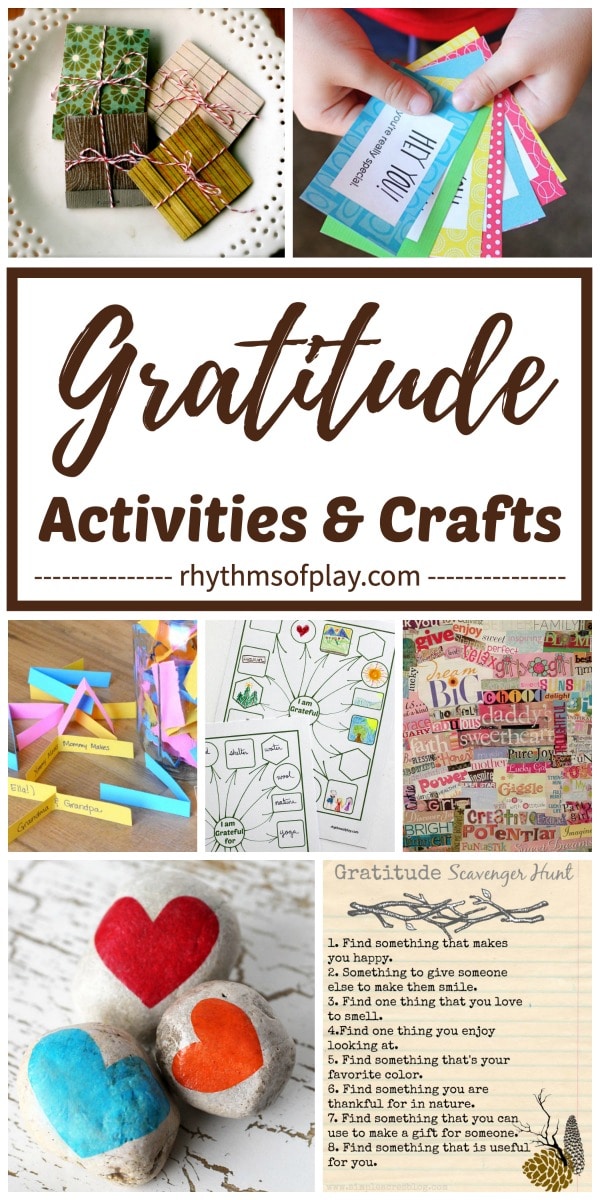
What is gratitude or Thankfulness?
Gratitude and thankfulness are powerful emotions that enrich our lives in profound ways. At its core, gratitude is a form of mindfulness that enables us to be present with our positive feelings, recognize the good things that happen, and appreciate the positive aspects of our lives, from simple pleasures to the most important people and events.
In other words, gratitude and grateful thinking are about expressing appreciation for the blessings in our lives instead of being fixated on the negative aspects of what we do not have. It is a positive emotion and a mindset of appreciating and being thankful for the good things in one’s life.
But thankfulness and gratitude go way beyond simply saying “thank you.” It’s a genuine acknowledgment of the value that people, experiences, and even challenges bring to our journey. This involves recognizing the kindness and support of others, acknowledging the value something or someone brings to our lives, fully appreciating our positive experiences, and looking for the positive outcomes of negative experiences with gratitude for lessons learned.
“When we are thankful for what we have, we will recieve more of what we are grateful for and find greater happiness in life.”
Nell Regan
Why is gratitude important?
Gratitude is an important and powerful emotion that brings numerous benefits to individuals and their relationships. By cultivating a grateful mindset and regularly practicing gratitude, we can enhance our well-being, foster positive connections with others, and lead more fulfilling lives.
Gratitude is researched to be associated with increased levels of optimism and empathy because it shifts the focus from what is lacking to what is present, promoting a positive outlook on life. Being thankful helps individuals appreciate the simple pleasures and joys in their daily experiences.
Feeling grateful can reduce stress, anxiety, and depression while promoting positive emotions and resilience. When we give more of our attention to the people, events, places, and things that we are thankful for, it can lead to the habit of feeling grateful and fulfilled.
Gratitude is a powerful reminder of the blessings and support we receive, and this thankfulness leads us to a more fulfilling and content existence. Because when we practice gratitude, and thankfulness becomes a way of being, we have a deeper appreciation for everything in our lives.
Grateful individuals tend to be more positive, resilient, and empathetic. This fosters a more harmonious and supportive social environment. Grateful individuals also tend to be more resilient in the face of adversity. Recognizing the positive aspects of life can provide a buffer against negative emotions during difficult times.
The fun gratitude crafts and activities on the list below can help children and adults establish the habit of paying attention to the good things in life. By cultivating gratitude, we can experience enhanced psychological well-being, better physical health, improved relationships, and several other benefits. Just look at how happy my daughter is in the photograph below.
How can you teach children about gratitude?
Teaching kids about gratitude is essential to their emotional and social development. Use the kids’ gratitude activities below to help you get started. Gratitude helps children appreciate what they have, fosters empathy, and promotes positive relationships. Fostering a grateful attitude can greatly impact children’s quality of life and the level of happiness they are able to experience. Below is a list of ten easy ways to teach kids about gratitude. By instilling these practices, we can nurture a sense of contentment, empathy, and kindness in children, empowering them to lead more fulfilling and compassionate lives.
1. Lead by example.
Children learn by observing the behavior of adults and caregivers. Demonstrate gratitude in your everyday life by expressing thanks and appreciation for what you have and the kindness you receive from others.
2. Count blessings.
Encourage children to take a moment to stop and count their blessings when good things happen in their lives. Or invite them to list three things they are grateful for each day. This practice helps them focus on the positive aspects of their lives.
3. Say “Thank You.”
Encourage children to say “thank you” when someone does something kind for them, such as giving them a gift, helping them with a task, or even a simple act of kindness like sharing a toy.
4. Avoid comparisons.
Teach children not to compare what they have (or don’t have) with others. Instead, encourage them to focus on their joy and appreciation for their unique blessings.
5. Random Acts of Kindness.
Engage children in acts of kindness for others, such as making a thank-you card for a friend, helping a family member with chores, or sharing their toys with others.
6. Donate and volunteer.
Involve children in charitable activities, like donating toys, clothes, or food to those in need or participating in community service events. This experience helps them understand the value of giving and empathy.
7. Share Gratitude.
During family meals or bedtime, take a moment to share and express gratitude with one another. Have a gratitude circle where each family member shares something they are thankful for that day. This activity fosters a sense of connection and appreciation within the family.
8. Gratitude journal.
Introduce the concept of a gratitude journal (or coloring page) where children can write or draw things they are thankful for each day. This practice can help them reflect on positive experiences and develop a grateful mindset.
9. Share stories.
Read children’s books about gratitude that inspire thankfulness. Or tell stories highlighting acts of kindness, compassion, generosity, and gratitude. This can inspire children to adopt similar attitudes and behaviors.
10. Have compassion and be patient.
Children might not fully grasp the concept of gratitude immediately. Be patient and encourage them gently to practice gratitude regularly.
Remember, teaching gratitude is an ongoing process. The best way to instill this value in children is to incorporate it into your daily rhythm or routine. The list of gratitude activities and gratitude crafts on the list below can help parents, teachers, and caregivers teach children how to express gratitude for life.
Gratitude Activities and Crafts for Children
Most families and classrooms approach the concept of gratitude and thankfulness at Thanksgiving and around the holidays. But the lists of gratitude activities and crafts below can help teach children simple lessons on gratitude, friendship, and generosity throughout the year. Scroll down to find preschool gratitude activities, kindergarten gratitude activities, games to teach gratitude, and fun gratitude activities for kids (and adults) of all ages!
Related: Children’s Gratitude Books That Inspire Thankfulness
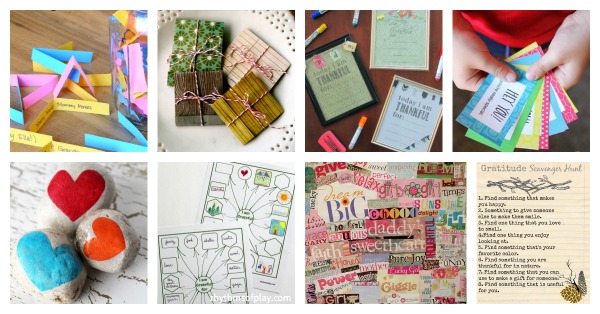
3 Gratitude Lessons
Suppose you are looking for a few effective ways to raise a grateful child or want to know how to teach children to be more grateful. The ideas and books on the list below provide valuable positive parenting tips for raising grateful kids in an entitled world. Use these simple lessons in gratitude and the gratitude crafts and activities on the lists below to teach kids about gratitude and thankfulness.
- Teaching Gratitude to Children with Gratitude Worksheet for Kids | Sight and Sound Reading
- Raising Grateful Kids in an Entitled World by Kirsten Welch
- The Me, Me, Me, Epidemic
: A Step-by-Step Guide to Raising Capable, Grateful Kids in an Over-Entitled World by Amy McCready
Related: Encouraging Kindness Towards Nature
8 Gratitude Activities for Kids (Thankful Activities)
Gratitude activities for preschoolers, kindergarteners, and kids of all ages (even the young at heart)! Try any of the fun activities below to nurture an attitude of gratitude in your home or classroom. You will find lots of fun gratitude crafts for kids (and adults) in the next section.
1. Start a Gratitude Journal.
- Download and print the “I Am Grateful for” gratitude journal free printable worksheet. Next, draw or write down everything that you have to be grateful for in the fun little boxes.
- Learn how to start a gratitude journal with “5 Simple Steps to Help Your Child Start a Gratitude Journal.” (By Growing Book by Book for Lasso the Moon.)
- Use printable gratitude journal prompts to help children learn to notice the blessings in their lives through the practice of gratitude journaling.
- Make one of the gratitude journals described in “Thankful Crafts” listed below, or download and print free printable gratitude journal pages for kids HERE or HERE.
- Gratitude Journal Tip: Use Wet-Erase Markers
and dry-erase pockets
or a laminator
and easy laminating sheets
to reuse gratitude journal printables over and over again instead of wasting printer ink and paper!
Related: Kids’ Books That Teach Important Life Lessons
2. Make it a Habit to Write “Thank You” Cards and Notes.
- Encourage children to write thank-you notes and cards for those who do nice things for them. Making and sending thank you cards is a fun way to thank loved ones for their generosity and love and help children cultivate a sense of gratitude.
- Use these simple free printable thank you cards and coloring notes for kids from A Girl and a Glue Gun to get started, or make homemade fingerprint lovebug thank you cards, as shown in the photograph below!
3. Make a Gratitude Wall or Dry Erase Board.
- Create a simple gratitude wall like this gratitude craft and activity from What Do We Do All Day. Feel free to make it your own and embellish it in any way you wish.
- Or, print out this free thankful dry-erase board from Bren Did to hang on the wall in a prominent place in your home or classroom. We have ours in the dining room and use it to share what we are grateful for at dinner each night.
4. Use Gratitude Drawing Prompts.
- Help your children understand and feel grateful through art with gratitude drawing prompts.
- Visit Lasso the Moon to find ten fun gratitude drawing prompts for kids.
- Or try this list of gratitude prompts with printable.
- Next, invite children to draw their answers onto the “I am Grateful” gratitude journal page!
5. Go on a Gratitude Scavenger Hunt or Thankful Nature Walk.
- Invite children to go on a gratitude scavenger hunt! Simple Acres has a free printable for a gratitude scavenger hunt that you can print and share with your children at home or in the classroom. Find the link to download and print HERE.
- Go on a gratitude photo scavenger hunt on Thanksgiving or any time of year. Pop over to Let’s Get Together to see how they did it!
- Encourage children to be kind to nature and express gratitude for the great outdoors by going on a thankful nature walk with children.
Related: Sensory Bin Nature Scavenger Hunt
6. Pass Out Smile it Forward Kindness Cards.
- A simple kindness activity that doubles as a fun gratitude activity for kids is to pass out smile it forward cards. Handing out “Smile It Forward Kindness Cards” is a great way to share kindness, appreciation, and gratitude with anyone who crosses your path.
- Download and print Smile It Forward kindness cards from the Kids Activities Blog.
7. Bake and Share Kindness Cookies.
- Baking and sharing kindness cookies is not just about delicious treats; it’s a heartwarming way to spread joy and make meaningful connections with others. Baking cookies together can be a delightful bonding experience for families and friends, creating cherished memories.
- But the real magic lies in the act of sharing these delectable treats with others. Whether it’s surprising a neighbor with a freshly baked batch, offering a warm cookie to a stranger, or sending a care package to service professionals or a friend in need, each act of kindness can brighten someone’s day and create a ripple effect of positivity.
- These small gestures of sweetness and thoughtfulness remind us of the power of simple acts of kindness to bring warmth and happiness into the world. So, let’s bake those scrumptious kindness cookies and spread the love, one cookie at a time!
8. Conduct a 28-90 Day Gratitude Challenge.
Embarking on a 28 to 90-day gratitude challenge is an exciting and transformative journey that can foster a culture of appreciation at home or in the classroom. Completing a 28 to 90-day gratitude challenge can be a powerful and rewarding experience that can transform attitudes and nurture a sense of gratitude far beyond the conclusion of the challenge.
- Express gratitude daily for 28-90 days (the longer the better) in order to make thankfulness and grateful thinking a habit:
- Draw or write in a gratitude journal or coloring page every day.
- Start a gratitude list of everything you appreciate about yourself, others, work, community, home life, nature, etc. Read this list and add to it daily.
- Share thankful thoughts daily during meals, around the classroom, or before bedtime. (Add these to your daily gratitude list.)
- Use gratitude prompts to add to your gratitude list.
- Read gratitude quotes or a book about gratitude aloud every day.
- Perform an act of kindness for others each day.
- Or, put a leaf on a thankful tree, a note in a blessing jar, a feather on a thankful turkey, a paper link on a gratitude garland or chain, etc., with something you are thankful for each day for a total of 28 to 90 days.
- Make gratitude a daily habit that extends beyond 90 days to live a grateful life filled with blessings that seem to magically multiply. To do so, continue to read your gratitude list, thankful leaves, and blessing jar entries, and use your favorite gratitude activities, games, and tools.
Benefits of a 90-day thankful challenge:
- Completing a 90-day gratitude challenge helps form the habit of thankfulness, making being grateful more likely to become a lasting part of one’s life and way of relating in and to the world.
- Gratitude and grateful thinking cultivate an optimistic mindset, improve mental well-being, and reduce stress.
- Participating in a 90-day gratitude challenge strengthens relationships and promotes empathy as participants learn to recognize and appreciate the support and kindness of others.
- A thankful challenge encourages mindfulness and a deeper connection with the present moment, helping children and adults savor the little joys in their lives.
Related: Kindness Cookies
9. Read Children’s Books About Gratitude and Thankfulness.
- Help nurture gratitude in the home or classroom with Children’s gratitude Books That Inspire Thankfulness.
- Click on the link or the image below to see our favorite gratitude books for kids.
10. Play Gratitude Games at Home or School.
- It’s fun to play games to teach gratitude. Gratitude games can help remind preschoolers, kindergarteners, and kids of all ages of the many things they have to be grateful for.
- Try the thankful game ideas on the list in the next section!
6 Gratitude Games for Kids and Adults (Thankful Games)
Learn how to play four different fun gratitude games with the ideas below. These gratitude games for kids are fun to play at home with family or school with classmates and friends.
1. Gratitude Pick-up Sticks.
- Count your blessings with this homemade version of Pick-up Sticks with a gratitude twist.
- This gratitude game is about expressing gratitude for a specific type of person, place, event, or thing, depending on the color of the pick-up stick you choose.
- Learn how to play the gratitude game on Teach Beside Me.
2. Punch Gratitude Game.
- Turn expressing gratitude into a fun activity for the whole family or classroom with THIS Gratitude Game.
3. M&M Gratitude Candy Game.
- Gather everyone to share what you’re thankful for while enjoying a little treat with THIS fun gratitude candy game for kids!
4. Gratitude Skittles Game
- The Skittles Gratitude Game is a fun way to get people talking about what they are most thankful for at home or in the classroom.
- Visit Play, Party, Plan to learn how to play this gratitude candy game and download the printable.
5. The ABCs of Gratitude Game.
- Play the Grateful ABC Game! Invite the kids (and grownups, too!) to sit down and take some time to think about what they are most thankful for.
- The challenge is to think of at least one thing or person they are grateful for that begins with each letter of the alphabet and write them down on a piece of paper.
- Learn more about the ABCs of Gratitude Game on The Keel Deal and how to play the Thankful ABCs on PJs and Paint.
6. Gratitude Dice Game.
- The Gratitude Dice Game is a fun way to remind kids to focus on what is important and how much they have to be thankful for.
- Learn how to play the Thankful Dice Game and download the printable on Mombright.
Related: How to Make a Thankful Tree with Clay Gratitude Leaves
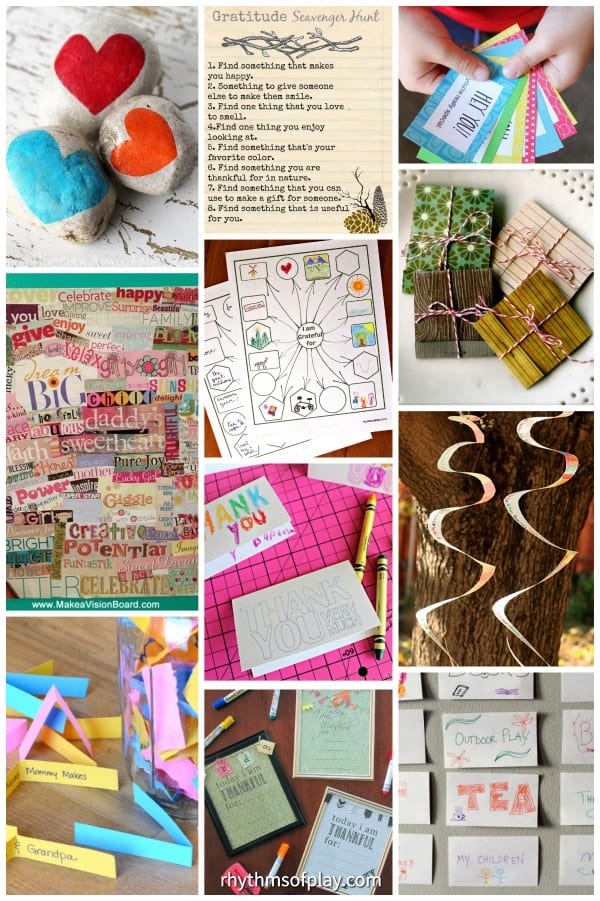
Related: Turkey Leaf Lantern Craft
9 Gratitude Crafts for Kids (Thankful Crafts)
Gratitude crafts and activities provide a simple way to help children learn how to express gratitude. Practicing gratitude is a beautiful way to help children develop an attitude of gratitude for life.
1. How to Make Homemade Gratitude Journals.
- Decorating gratitude journal crafts for kids is a fun way to teach gratitude. Learn how to make a DIY cover for gratitude journals on The Chaos and the Clutter.
- Another fun gratitude craft similar to a gratitude journal is a thankful book for toddlers, preschoolers, and kindergarteners, a thankful book like THIS from Mama’s Happy Hive. Help children (especially young children who don’t know how to write yet) with this fun gratitude exercise for kids.
Related: How to Make and Keep a Nature Journal
2. Create Gratitude Stones Crafts.
- Gratitude stones are a simple gratitude craft for preschoolers, kindergarteners, and kids of all ages. Learn how to make Gratitude Stones, such as the gratitude stones found HERE, to cultivate an attitude of gratitude from an early age.
- Another fun idea is to make painted rocks with words of gratitude. Stones painted with thankful words can even be hidden for others to find!
Related: How to Paint Rocks
3. Make a Vision Board or Gratitude Collage.
- Making a gratitude vision board is one of my favorite gratitude activities and crafts for kids and adults.
- Help your children (or students) learn how to make a gratitude board like the vision board for kids found HERE. Don’t forget to make a gratitude collage for yourself while you’re at it!
4. Use a Gratitude Jar, Thankfulness Jar, or Blessing Jar.
- Teaching our kids to be grateful is one of the most important lessons we can share with children. Invite children to count their blessings with a Thankfulness Jar activity.
- Putting prayers and messages of thanks into a gratitude jar is a simple way to help our kids become more grateful. All you need to do is encourage children to write what they are grateful for onto strips of paper and put them into the Thankful Jar.
- Place the gratitude jar on a table or shelf and encourage everyone in the home or classroom to fill it with everything they are grateful for.
- Learn how to make a thankful blessing jar HERE, or purchase one HERE
or HERE
.
- Or make a leaf lantern, heart luminary, or turkey lantern and use it as a gratitude jar.
5. Make a Gratitude Tree and Thankful Leaves.
- Thankful trees are fun to make the month of November (or October in Canada) for Thanksgiving but can be used as a fun gratitude craft and activity all year.
- Use a paint pen
to write everything you are grateful for on real leaves, as shown in the photograph below, with this easy DIY Thankful Tree.
- Make clay gratitude leaves to decorate your thankful tree with this simple gratitude craft for children and adults.
- Download and print this gorgeous gratitude tree with thankful leaves and use it to express what you are most thankful for.
- For even more Gratitude or Thankful Tree ideas, look at this list of Thankful Trees you can make and use with children at home or in the classroom.
6. Gratitude Sunflower Craft.
- Inspire preschoolers to express gratitude with THIS fun gratitude craft.
- Invite children to use each sunflower petal to represent something they are thankful for.
Related: Growing Sunflowers with Children
7. DIY Gratitude Mobile or Wind Spinners.
- Create a gratitude mobile and hang it somewhere everyone sees daily.
- Or make some thankful wind spinners like THESE by Make and Takes.
8. Create a Simple Gratitude Garland Craft.
- Gratitude Garlands are another wonderful way to help children realize everything they have to be thankful for.
- Making a Gratitude Garland Craft is easy. Follow the simple steps below:
- First, cut pieces of construction paper, or use THESE pre-cut strips.
- Next, ask family and friends (or students) to write what they are grateful for on each piece of paper.
- Finally, loop the strips of paper around each other and glue the strips of paper end to end to make a gratitude garland paper chain.
- Or punch a hole into each piece of construction paper and thread them onto a string, ribbon, or yarn to make a thankful garland, as shown HERE.
9. Make a Thankful Turkey or Gratitude Pumpkin Craft.
- Visit Thanksgiving gratitude activities and crafts to see several fun gratitude crafts you can make for Thanksgiving, including a gratitude pumpkin craft and a few fun thankful turkey crafts like THIS printable placemat you can download, print, and decorate.
Related: The Best Nature Study Supplies for Kids
Thankful Gratitude Activities and Crafts for Kids
Showing gratitude with these simple gratitude activities and gratitude crafts for kids can create an attitude of gratitude in the home or classroom.
Expressing gratitude and thankfulness is researched to be associated with increased levels of optimism and empathy. When we are thankful for what we have, we get more of what we are grateful for. Thus, when we are grateful, we can find greater happiness in life.
This collection of gratitude activities and crafts can help parents and educators teach children how to express gratitude for life. If you are looking for fun gratitude activities to do on and around Thanksgiving, check out this incredible collection of Thanksgiving gratitude activities and crafts.
Don’t wait–share your gratitude today! Click on the link to learn more about Rhythms of Play!
More Crafts and Activities for Kids
- Awesome Autumn Activities for Kids with Printable Fall Bucket List
- Winter Activities for Kids with a Printable Winter Bucket List
- Fun Spring Activities for Kids with Printable Spring Bucket List
- Summer Activities for Kids with Printable Summer Bucket List
- Outdoor Activities for Kids
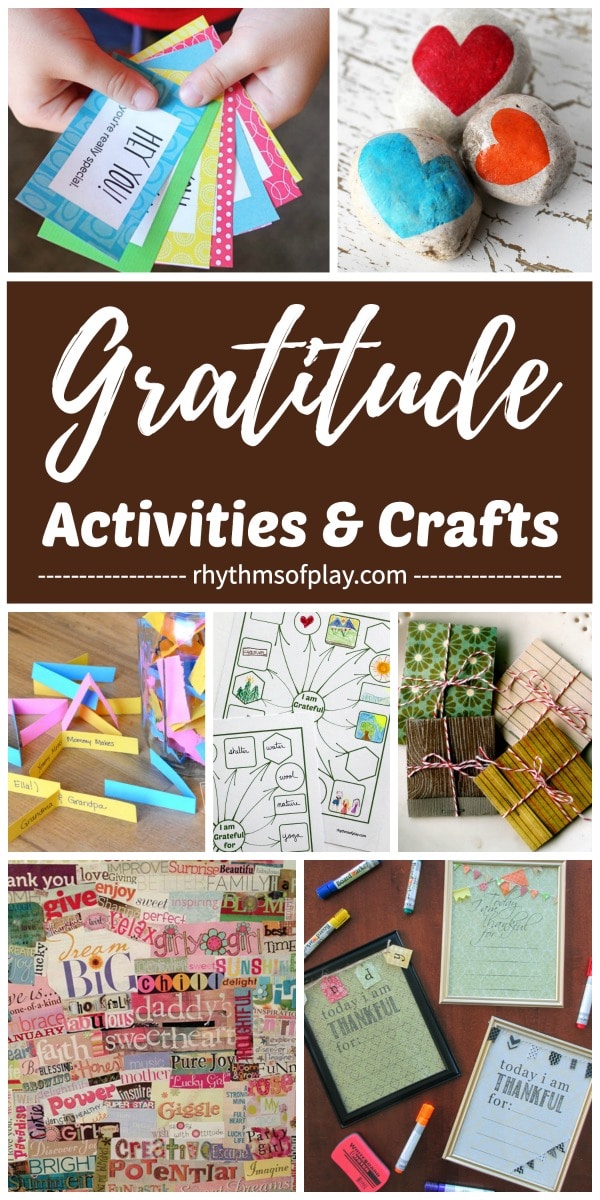

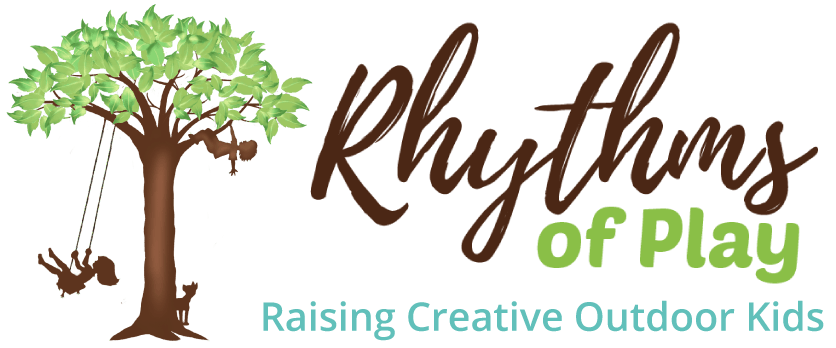
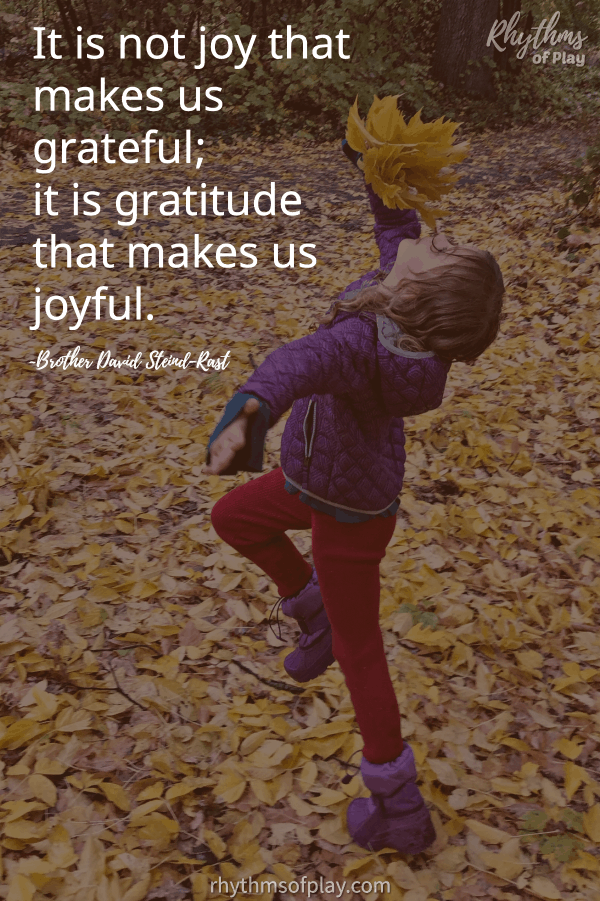
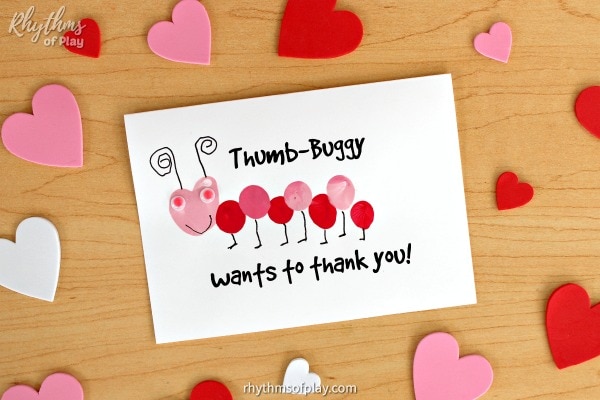
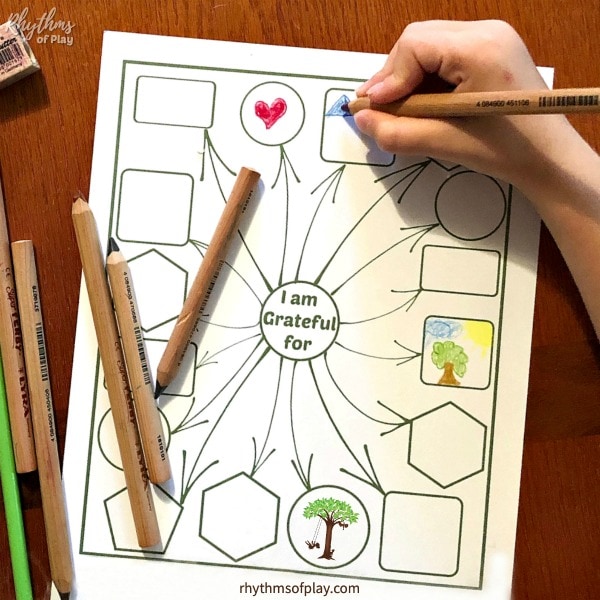


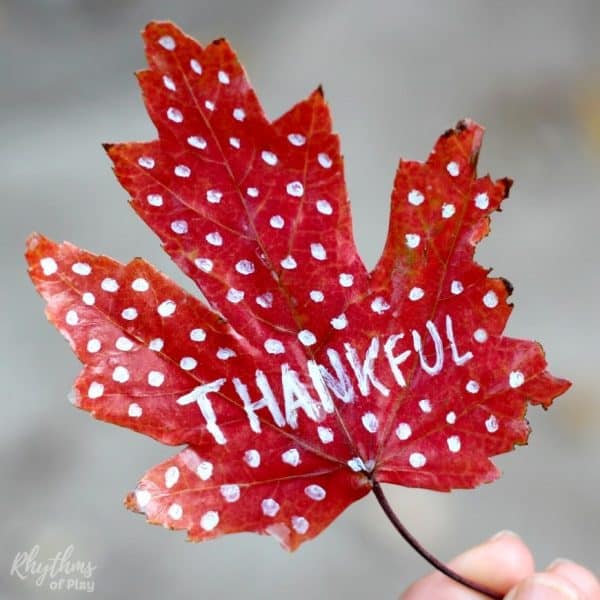

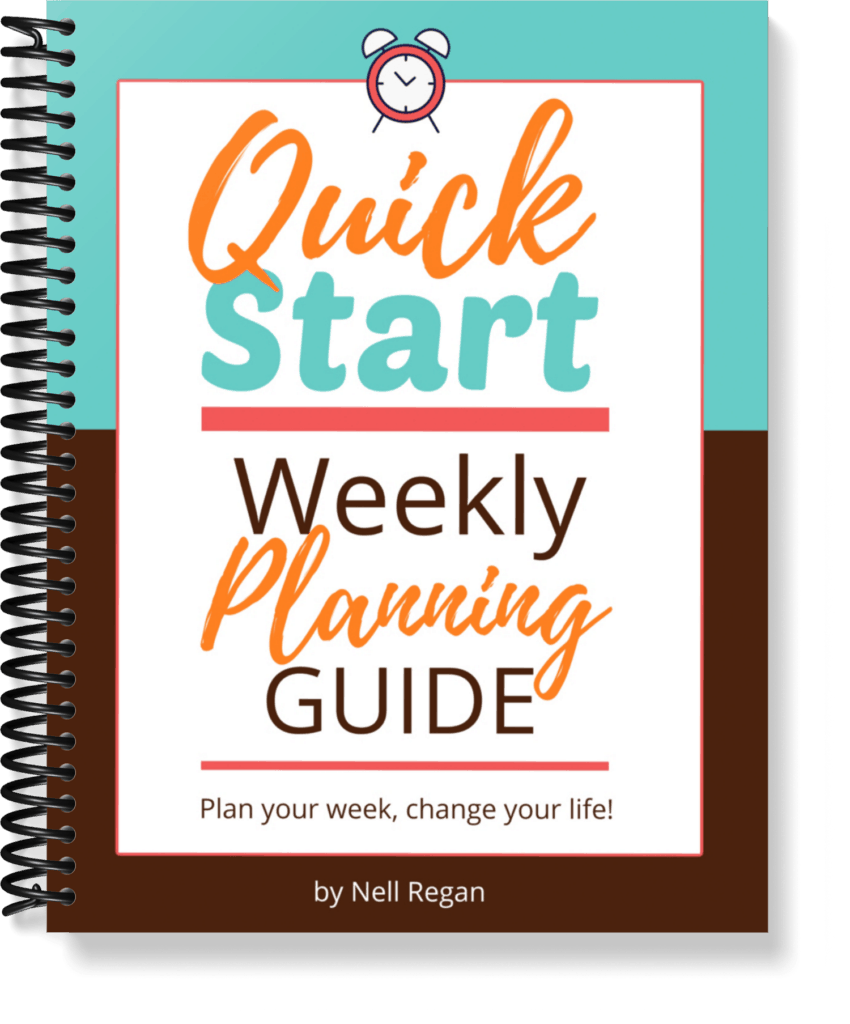
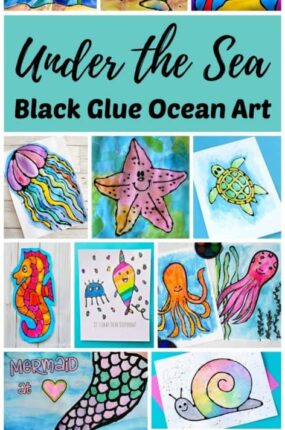
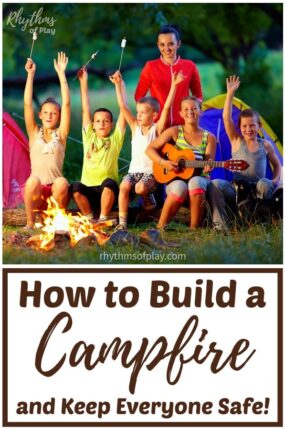
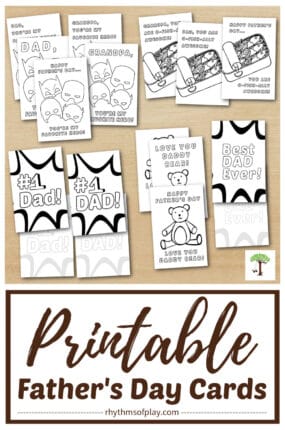

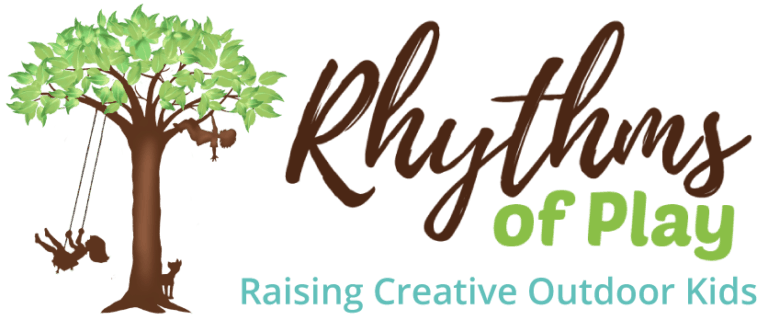
Pinning, That was a great idea and a lot of inspiration thanks.
Thanks, Boyd! I’m so glad that you found it useful!
With Thanksgiving coming up, it’s important to remind our kids how important it is to stay positive when you build relationships with peers and how rewarding it is to give something you can share. These don’t necessarily need to be things but feelings, such as kindness, honesty, friendship, acceptance, and gratitude.
As a teacher, I plan my whole year around teaching kids life-important skills. Thank you for providing so many great ways to help them learn about gratitude and how to be thankful.
Hi Alicia,
I agree with you one hundred percent! I created this list because I need to stay positive and build relationships around feelings such as gratitude. I’m so glad that you find it useful! Happy Thanksgiving!